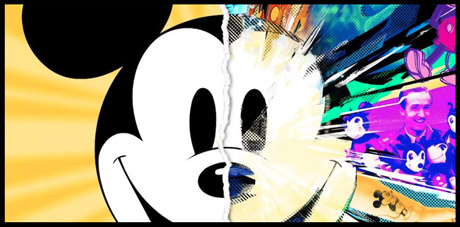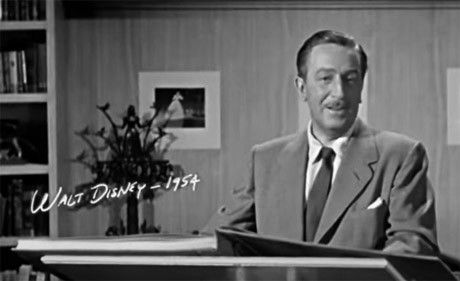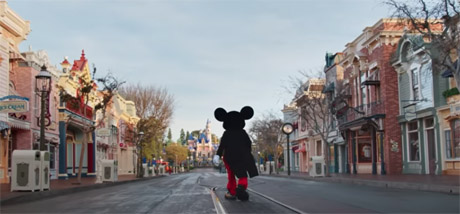
Tomorrow, Friday November 18th, is Mickey Mouse’s 94th Birthday. To celebrate, Disney+ is premiering a new 90-minute documentary on the iconic character. Mickey: The Story of a Mouse is directed by Jeff Malmberg. He discusses the deep exploration into every aspect of Walt’s beloved creation in this Animation Scoop Q&A. (This interview was edited for length and clarity.)
Jackson Murphy: You won a Critics Choice Documentary Award… I was just at the most recent ceremony the other night… for your editing work on “Won’t You Be My Neighbor?”, the Mr. Rogers documentary. Now Mickey Mouse. You’re attracted to the icons!
Jeff Malmberg: (laughs) What I think about with the Critics Choice Documentary Award is how heavy that award is. I gave it to my daughter. She just started dropping it. I had to take it back. If somebody breaks into my house, I am grabbing that award and I’m using it like a hammer for self-defense. I’m telling you: that thing is weighty!

Murphy: Clearly powerful in multiple ways. I screened the film back in September and really enjoyed it. What’s the biggest thing about Mickey you either really wanted to set the record straight about or just get across?
Malmberg: It’s strangely this thing that we all share. It’s as close to joy as we’re ever gonna get as a symbol, which is very bizarre. This little mouse is something that puts a smile on all our faces. I grew up in the ’80s. Mickey was great. He was my nightlight. He greeted me at the park at Disneyland. My parents were super excited to take my picture with him. I was excited. But I didn’t really understand that he was this Chaplin-level actor in early animation and so much at the center of early film and animation history. For me… it’s not like I’m an authority and therefore I will make a movie. It’s more like I like something and I have questions about it. That’s kind of how I roll in terms of documentaries I want to do. Mickey to me was instantly… I love Mickey, but I’ve also got some questions, so maybe we can figure out these questions.
Murphy: You address a lot for sure. And you go through the different generations of Mickey, in terms of his design and personality. What’s the design and/or personality that speaks to you the most?
Malmberg: I would say… the 1939 / 1940 Mickey — The Little Whirlwind. It’s kind of the freest Mickey ever was, in terms of the design. There’s something so beautiful about Mickey. My two favorite shorts are Little Whirlwind and The Brave Little Tailor. That kind of era of Mickey, pre-WWII… you can’t beat them.

Jeff Malmberg and Jackson Murphy
Murphy: You mentioned 1940, which is when Fantasia came out. And you dive into the fact that Fantasia was aimed to be a real comeback for Mickey. At that time, Donald and Goofy were becoming more popular, and Mickey needed a chance to get back into the spotlight.
Malmberg: Yeah, absolutely. Mickey gets so big that he kind of loses his ability to have emotions, in a way. Those emotions are sent off to Donald or Goofy or whoever is appropriate for the story. Mickey is sort of this host, straight man, and that’s not really, I don’t think, where he operates best. What we respond to in that character is a character who’s small but mighty, who’s trying hard, who’s never gonna give up, who has this perseverance and joy. By that time, he was really in need of a comeback. A lot of the other characters were having much more fun than he was. Mickey wasn’t even allowed to have fun anymore.
Murphy: And fascinating to see the clips you chose of Walt Disney. How was it choosing which ones you wanted in this?
Malmberg: One of the great things about working on the film with Disney was that Walt Disney had, smartly, filmed himself in all these situations. If you wanted images, Walt probably shot it. (laughs) It was fun to see that early studio stuff — stuff that you wouldn’t normally have access to. We’re talking about the mid-’20s when he’s struggling as an animator. Yet, lo and behold, he’d be there… he made a short about what it was like to be an animator. We would use that. Treasure trove of archival material.

Murphy: How did you discover this cool new “Mickey in a Minute” short could be the throughline for this documentary?
Malmberg: That was one of the things I really enjoyed — getting to watch Eric Goldberg, Mark [Henn] and Randy [Haycock] work. They were doing, not just the Mickey short, but hand-drawn, the same way Mickey had originally, always been animated. It was natural, as we worked through this timeline, to have this progression of the short being made. I always felt like I wasn’t gonna get any closer to Mickey than the tip of Eric’s pencil on that page. Watching Eric work… I’m sure I shot way more than I ever needed because I couldn’t help myself. He is a great guy. He almost embodies Mickey, in a way.
Murphy: Yes! I interviewed him in the spring for his “Sketchbook” episode of The Genie for Disney+. What a joyous guy to talk with. You’re able to showcase this talent and beautiful hand-drawn animation.
Malmberg: Absolutely. People are always saying, “What’s Mickey gonna do next?” I’m not smart enough to answer that question but I do say that I hope whatever it is it’s done hand-drawn. As a parent, I watch CG animated features with my daughter all the time. But there’s something to hand-drawn that’s really special and needs to keep going.

Eric Goldberg
Murphy: I completely agree with you. Mickey and Donald were huge influences during WWII, The Holocaust and The Vietnam War. When you came across some of the key moments, and there’s one in particular that got me emotionally, how did that make you feel — and realize as a filmmaker, “Wow. I HAVE to use this?”
Malmberg: I knew going in that I wanted to explore was not just the on-brand Mickey but the off-brand Mickey. Taking copyright out of the equation (which is another aspect of it), taking the idea that people were so enamored with this character and he was so filled with meaning at that time, they would take him and use him in different ways, very emotional ways. I wanted the film to include that. As somewhat of an art freak, I think what Milton Glaser did with Mickey Mouse in Vietnam has just as much value as some of the on-brand shorts, so to speak. It shows how close we are to that character — we’re using him and adapting him to our own means and our own ways of expressing things. That was really important. And some of the WWII stuff had real meaning.
Murphy: All of us of any age can find some way to identify with Mickey. What do you think, after interviewing some people who are true Mickey fans with all the merchandise, having so much of Mickey in one place (and those three circle shapes) really says about a person?
Malmberg: It says they’re able to find that little bit of childhood joy inside them. Ultimately that’s a real invitation to going back to that. I’m not that person, frankly. I wish I was more like that. And I think the movie maybe taught me to really grab as much joy as I could get and use it. Mickey’s a good reminder that there was a time where we were all innocent. When I see people like that, I’m fascinated. I totally admire their spirit. I’m the guy behind the camera. I’m not that interesting. But seeing people like that I find beautiful. I love it.

Murphy: One of the most fascinating people you interview in this movie is Bob Iger. My whole lifetime, growing up with him at the center of it all and the decisions he has made that have been so influential to Disney and our world. How was it interviewing Bob Iger and having him be a part of this?
Malmberg: When you’re looking at the scope and shape of the film, there’s a period in the middle where (post-Walt’s death) Mickey, on a brand level, him as a character, he really means nothing anymore. He’s not on screen. He’s nothing but a product and a park greeter. The character is completely lost. In talking to people both inside and outside of Disney about that time, all roads really led to Bob Iger. He was really the one who, like a lot of people, loved Mickey as a kid and knew he had stopped being what he was.
At the same time all these people outside of Disney are playing with Mickey, Mickey (inside Disney) means very little. He’s on a check. He’s greeting fans but I remember that. It wasn’t the same as what you’re seeing in the ’30s, ’40s and ’50s. It’s definitely a situation where [Iger] was definitely able to articulate what Mickey had been and what he no longer was. To me, that back end of the film is as simple as: Say what you want about Mickey as a consumer product… there’s no denying that… but it won’t ever be anything but what it is, I don’t think. But the release of Mickey as a character and his ability to be himself again and have emotions and be played with by creative people… it sounds so simple but that was completely off the table. Just the ability to say, “Do what you want with him because I know you love him as an animator. Go with it and do those things!” It sounds very simple, but it was a sea change in terms of how Mickey was thought about.
Murphy: We’re six years away from Mickey turning 100. How do you hope that 100th celebration goes for Mickey?
Malmberg: As long as he is hand-drawn, I’m all for it. I don’t know what form it’s gonna take — if it’s a short, if it’s a feature. I have no idea. I’m not that smart. But I do know that having done this film, hand-drawn animation is not to be forgotten or ignored or downplayed, and Mickey’s the easiest way to understand the beauty of it.
- INTERVIEW: Jeff Fowler On “Knuckles” And “Sonic 3” - April 22, 2024
- INTERVIEW: “Inside Out 2” Director And Producer On Pixar Sequel - April 16, 2024
- INTERVIEW: “Puffin Rock And The New Friends” And 25 Years Of Cartoon Saloon - April 10, 2024


 November 17th, 2022
November 17th, 2022  Jackson Murphy
Jackson Murphy  Posted in
Posted in  Tags:
Tags: 






